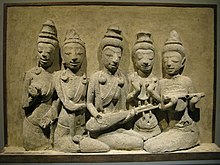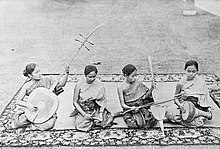Mahori
It combines the xylophones and gong circles (but not the pi, or oboe) of the piphat with the strings of the khruang sai ensemble.
Mahori is a form of Thai classical music that has a long history in Thailand, dating back to at least the Ayutthaya period.
[7] And also, Nicolas Gervaise, a French priest and traveler who had visited Ayutthaya, recorded a Mahori music called "Sout Chai" in the book Histoire Naturelle et Politique du Royaume de Siam in 1688.
[2] The Wong Mahori consists of both the string and piphat instruments, often reduced in size to accommodate female performers.
[2] While Thai classical music was somewhat discouraged as being outmoded and backward-looking during Thailand's aggressively nationalistic modernization policies of the mid-twentieth century, the classical arts have benefited recently from increased governmental sponsorship and funding as well as popular interest as expressed in such films as Homrong: The Overture (2003), a popular fictionalized biography of a famous early 20th century ranat ek player and composer Luang Pradit Phairao.


